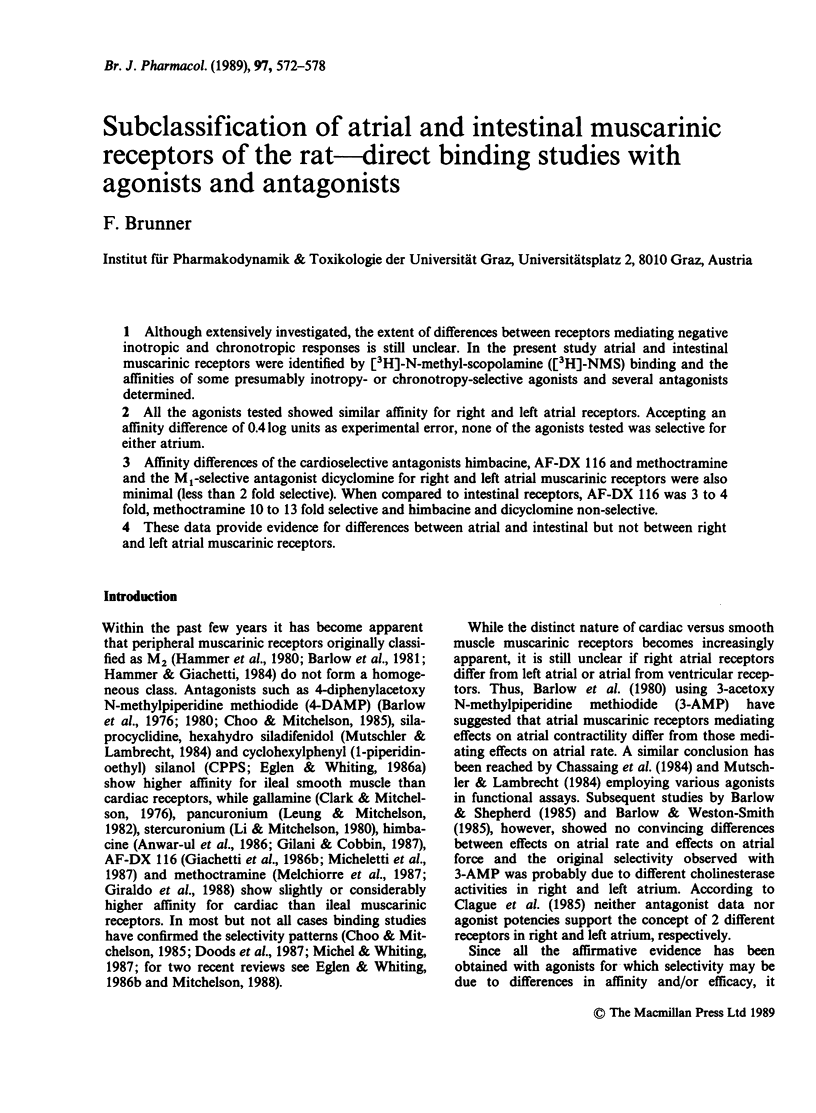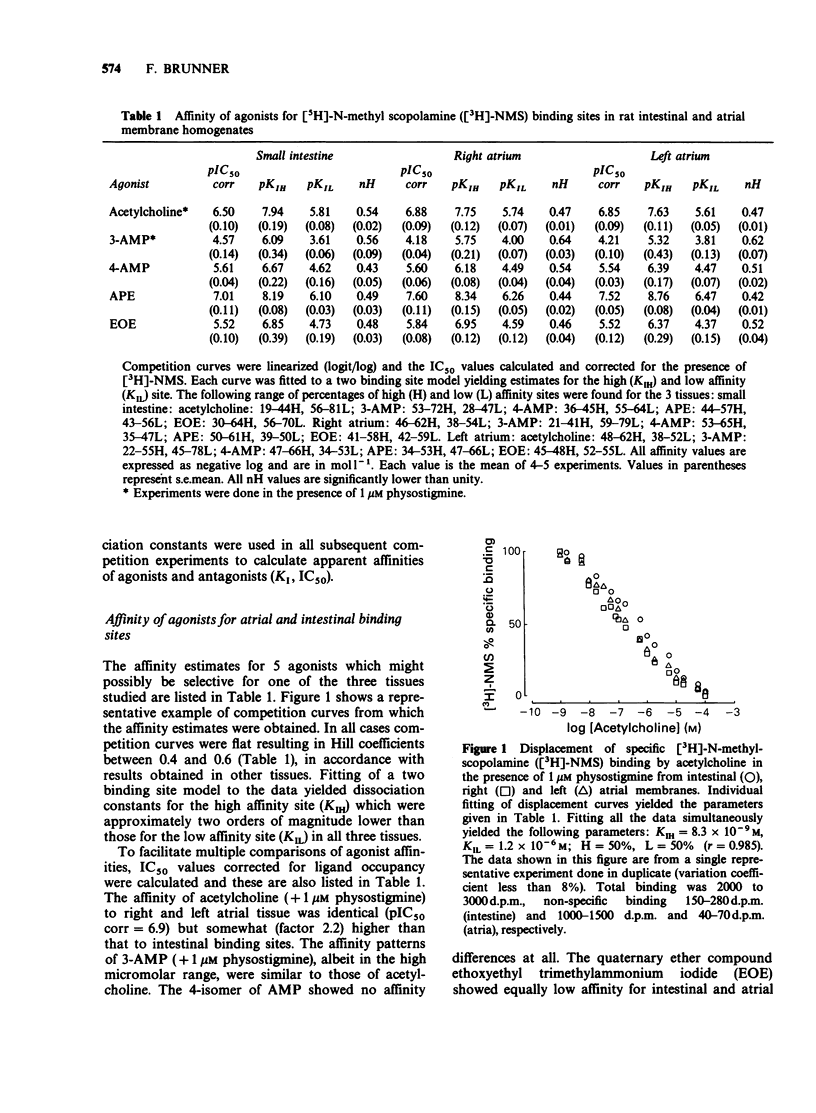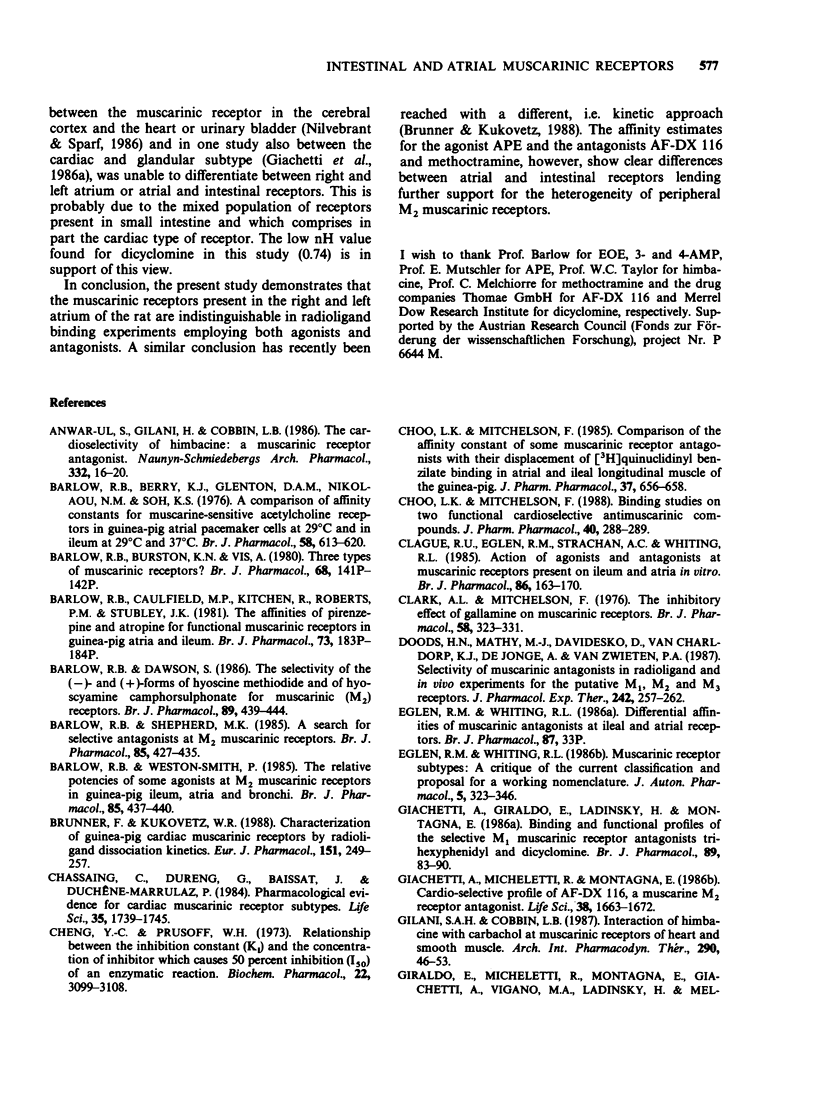Abstract
1. Although extensively investigated, the extent of differences between receptors mediating negative inotropic and chronotropic responses is still unclear. In the present study atrial and intestinal muscarinic receptors were identified by [3H]-N-methyl-scopolamine ([3H]-NMS) binding and the affinities of some presumably inotropy- or chronotropy-selective agonists and several antagonists determined. 2. All the agonists tested showed similar affinity for right and left atrial receptors. Accepting an affinity difference of 0.4 log units as experimental error, none of the agonists tested was selective for either atrium. 3. Affinity differences of the cardioselective antagonists himbacine, AF-DX 116 and methoctramine and the M1-selective antagonist dicyclomine for right and left atrial muscarinic receptors were also minimal (less than 2 fold selective). When compared to intestinal receptors, AF-DX 116 was 3 to 4 fold, methoctramine 10 to 13 fold selective and himbacine and dicyclomine non-selective. 4. These data provide evidence for differences between atrial and intestinal but not between right and left atrial muscarinic receptors.
Full text
PDF






Selected References
These references are in PubMed. This may not be the complete list of references from this article.
- Anwar-ul S., Gilani H., Cobbin L. B. The cardio-selectivity of himbacine: a muscarine receptor antagonist. Naunyn Schmiedebergs Arch Pharmacol. 1986 Jan;332(1):16–20. doi: 10.1007/BF00633191. [DOI] [PubMed] [Google Scholar]
- Barlow R. B., Berry K. J., Glenton P. A., Nilolaou N. M., Soh K. S. A comparison of affinity constants for muscarine-sensitive acetylcholine receptors in guinea-pig atrial pacemaker cells at 29 degrees C and in ileum at 29 degrees C and 37 degrees C. Br J Pharmacol. 1976 Dec;58(4):613–620. doi: 10.1111/j.1476-5381.1976.tb08631.x. [DOI] [PMC free article] [PubMed] [Google Scholar]
- Barlow R. B., Burston K. N., Vis A. Three types of muscarinic receptors? [proceedings]. Br J Pharmacol. 1980 Jan;68(1):141P–142P. [PMC free article] [PubMed] [Google Scholar]
- Barlow R. B., Dawson S. The selectivity of the (-)-and (+)-forms of hyoscine methiodide and of hyoscyamine camphorsulphonate for muscarinic (M2) receptors. Br J Pharmacol. 1986 Oct;89(2):439–444. doi: 10.1111/j.1476-5381.1986.tb10278.x. [DOI] [PMC free article] [PubMed] [Google Scholar]
- Barlow R. B., Shepherd M. K. A search for selective antagonists at M2 muscarinic receptors. Br J Pharmacol. 1985 Jun;85(2):427–435. doi: 10.1111/j.1476-5381.1985.tb08878.x. [DOI] [PMC free article] [PubMed] [Google Scholar]
- Barlow R. B., Weston-Smith P. The relative potencies of some agonists at M2 muscarinic receptors in guinea-pig ileum, atria and bronchi. Br J Pharmacol. 1985 Jun;85(2):437–440. doi: 10.1111/j.1476-5381.1985.tb08879.x. [DOI] [PMC free article] [PubMed] [Google Scholar]
- Brunner F., Kukovetz W. R. Characterization of guinea-pig cardiac muscarinic receptors by radioligand dissociation kinetics. Eur J Pharmacol. 1988 Jul 7;151(2):249–257. doi: 10.1016/0014-2999(88)90805-9. [DOI] [PubMed] [Google Scholar]
- Chassaing C., Dureng G., Baissat J., Duchêne-Marullaz P. Pharmacological evidence for cardiac muscarinic receptor subtypes. Life Sci. 1984 Oct 22;35(17):1739–1745. doi: 10.1016/0024-3205(84)90270-4. [DOI] [PubMed] [Google Scholar]
- Cheng Y., Prusoff W. H. Relationship between the inhibition constant (K1) and the concentration of inhibitor which causes 50 per cent inhibition (I50) of an enzymatic reaction. Biochem Pharmacol. 1973 Dec 1;22(23):3099–3108. doi: 10.1016/0006-2952(73)90196-2. [DOI] [PubMed] [Google Scholar]
- Choo L. K., Mitchelson F. J. Comparison of the affinity constant of some muscarinic receptor antagonists with their displacement of [3H]quinuclidinyl benzilate binding in atrial and ileal longitudinal muscle of the guinea-pig. J Pharm Pharmacol. 1985 Sep;37(9):656–658. doi: 10.1111/j.2042-7158.1985.tb05106.x. [DOI] [PubMed] [Google Scholar]
- Choo L. K., Mitchelson F. Binding studies on two functional cardioselective antimuscarinic compounds. J Pharm Pharmacol. 1988 Apr;40(4):288–289. doi: 10.1111/j.2042-7158.1988.tb05247.x. [DOI] [PubMed] [Google Scholar]
- Clague R. U., Eglen R. M., Strachan A. C., Whiting R. L. Action of agonists and antagonists at muscarinic receptors present on ileum and atria in vitro. Br J Pharmacol. 1985 Sep;86(1):163–170. doi: 10.1111/j.1476-5381.1985.tb09446.x. [DOI] [PMC free article] [PubMed] [Google Scholar]
- Clark A. L., Mitchelson F. The inhibitory effect of gallamine on muscarinic receptors. Br J Pharmacol. 1976 Nov;58(3):323–331. doi: 10.1111/j.1476-5381.1976.tb07708.x. [DOI] [PMC free article] [PubMed] [Google Scholar]
- Doods H. N., Mathy M. J., Davidesko D., van Charldorp K. J., de Jonge A., van Zwieten P. A. Selectivity of muscarinic antagonists in radioligand and in vivo experiments for the putative M1, M2 and M3 receptors. J Pharmacol Exp Ther. 1987 Jul;242(1):257–262. [PubMed] [Google Scholar]
- Eglen R. M., Whiting R. L. Muscarinic receptor subtypes: a critique of the current classification and a proposal for a working nomenclature. J Auton Pharmacol. 1986 Dec;6(4):323–346. doi: 10.1111/j.1474-8673.1986.tb00661.x. [DOI] [PubMed] [Google Scholar]
- Giachetti A., Giraldo E., Ladinsky H., Montagna E. Binding and functional profiles of the selective M1 muscarinic receptor antagonists trihexyphenidyl and dicyclomine. Br J Pharmacol. 1986 Sep;89(1):83–90. doi: 10.1111/j.1476-5381.1986.tb11123.x. [DOI] [PMC free article] [PubMed] [Google Scholar]
- Giachetti A., Micheletti R., Montagna E. Cardioselective profile of AF-DX 116, a muscarine M2 receptor antagonist. Life Sci. 1986 May 5;38(18):1663–1672. doi: 10.1016/0024-3205(86)90410-8. [DOI] [PubMed] [Google Scholar]
- Gilani S. A., Cobbin L. B. Interaction of himbacine with carbachol at muscarinic receptors of heart and smooth muscle. Arch Int Pharmacodyn Ther. 1987 Nov;290(1):46–53. [PubMed] [Google Scholar]
- Giraldo E., Micheletti R., Montagna E., Giachetti A., Viganò M. A., Ladinsky H., Melchiorre C. Binding and functional characterization of the cardioselective muscarinic antagonist methoctramine. J Pharmacol Exp Ther. 1988 Mar;244(3):1016–1020. [PubMed] [Google Scholar]
- Giraldo E., Monferini E., Ladinsky H., Hammer R. Muscarinic receptor heterogeneity in guinea pig intestinal smooth muscle: binding studies with AF-DX 116. Eur J Pharmacol. 1987 Sep 23;141(3):475–477. doi: 10.1016/0014-2999(87)90568-1. [DOI] [PubMed] [Google Scholar]
- Hammer R., Berrie C. P., Birdsall N. J., Burgen A. S., Hulme E. C. Pirenzepine distinguishes between different subclasses of muscarinic receptors. Nature. 1980 Jan 3;283(5742):90–92. doi: 10.1038/283090a0. [DOI] [PubMed] [Google Scholar]
- Hammer R., Giraldo E., Schiavi G. B., Monferini E., Ladinsky H. Binding profile of a novel cardioselective muscarine receptor antagonist, AF-DX 116, to membranes of peripheral tissues and brain in the rat. Life Sci. 1986 May 5;38(18):1653–1662. doi: 10.1016/0024-3205(86)90409-1. [DOI] [PubMed] [Google Scholar]
- Leung E., Mitchelson F. The interaction of pancuronium with cardiac and ileal muscarinic receptors. Eur J Pharmacol. 1982 May 7;80(1):1–9. doi: 10.1016/0014-2999(82)90171-6. [DOI] [PubMed] [Google Scholar]
- Li C. K., Mitchelson F. The selective antimuscarinic action of stercuronium. Br J Pharmacol. 1980 Oct;70(2):313–321. doi: 10.1111/j.1476-5381.1980.tb07938.x. [DOI] [PMC free article] [PubMed] [Google Scholar]
- Melchiorre C., Angeli P., Lambrecht G., Mutschler E., Picchio M. T., Wess J. Antimuscarinic action of methoctramine, a new cardioselective M-2 muscarinic receptor antagonist, alone and in combination with atropine and gallamine. Eur J Pharmacol. 1987 Dec 1;144(2):117–124. doi: 10.1016/0014-2999(87)90509-7. [DOI] [PubMed] [Google Scholar]
- Michel A. D., Whiting R. L. Direct binding studies on ileal and cardiac muscarinic receptors. Br J Pharmacol. 1987 Dec;92(4):755–767. doi: 10.1111/j.1476-5381.1987.tb11379.x. [DOI] [PMC free article] [PubMed] [Google Scholar]
- Micheletti R., Montagna E., Giachetti A. AF-DX 116, a cardioselective muscarinic antagonist. J Pharmacol Exp Ther. 1987 May;241(2):628–634. [PubMed] [Google Scholar]
- Mitchelson F. Muscarinic receptor differentiation. Pharmacol Ther. 1988;37(3):357–423. doi: 10.1016/0163-7258(88)90005-8. [DOI] [PubMed] [Google Scholar]
- Nilvebrant L., Sparf B. Dicyclomine, benzhexol and oxybutynine distinguish between subclasses of muscarinic binding sites. Eur J Pharmacol. 1986 Apr 9;123(1):133–143. doi: 10.1016/0014-2999(86)90697-7. [DOI] [PubMed] [Google Scholar]
- Wiemer G., Wellstein A., Palm D., von Hattingberg H. M., Brockmeier D. Properties of agonist binding at the beta-adrenoceptor of the rat reticulocyte. Naunyn Schmiedebergs Arch Pharmacol. 1982 Oct;321(1):11–19. doi: 10.1007/BF00586342. [DOI] [PubMed] [Google Scholar]
- Wong H. M., Sole M. J., Wells J. W. Assessment of mechanistic proposals for the binding of agonists to cardiac muscarinic receptors. Biochemistry. 1986 Nov 4;25(22):6995–7008. doi: 10.1021/bi00370a037. [DOI] [PubMed] [Google Scholar]


